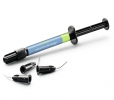
Tip #1: Use it to line the bases of your restorations
Most clinicians agree that flowable composite has outstanding performance as liners for deep restorations in the posterior. It’s the most common use of flowable composites in day-to-day practice.
Les Crawford, DDS, practices in Maumee, OH, outside of Toledo, with Namay Dentistry. Dr. Crawford uses flowable composite in deep posterior direct restorations with irregularities on the surface of the base. Then, he finishes with a high-filler packable composite. The low viscosity and self-leveling properties of the flowable composite make it an optimal base.
“It flows right into all those weird grooves and little caverns I make when I'm taking out the decay. It levels the surface and makes it a little bit easier to fill for the rest of it afterward,” Dr. Crawford says.
Dr. Crawford says he only uses flowable composite in direct posterior restorations where it has proven to work. He feels that using it in the anterior is risky for esthetics. Flowable composite is more translucent than conventional composite, Dr. Crawford explains. When used in anterior restorations, the light passes through the composite into the open oral cavity behind and the tooth looks gray.
"No one wants a gray tooth,” Dr. Crawford says.

Tip #2: Lay the groundwork for your flowable carefully
Edward Kusek, DDS, is a private practice general dentist in Sioux Falls, SD, with 34 years of experience. Dr. Kusek also uses flowable composite as a base or a liner in the box area of his direct restorations with bulk fill composites.
After placing two layers of his bonding agent, Dr. Kusek says he adds a thin layer of flowable composite and cures it. The flowable helps prevent any voids as he compresses the bulk fill composite on top.
“If I'm doing a Class II, I like to put a little bit of flowable into the box area and go over it with an explorer to thin it out and ensure I get out any bubbles. I put the flowable in there and cure it because it seals that box up a little bit better for me,” Dr. Kusek says. “Mine isn’t super thick, so it will level out, but you still need to move it around a little bit.”
One of the things Dr. Kusek looks for in his flowable composite is high radiopacity. It helps him distinguish between the restoration and secondary caries at future appointments with the patient.
“Otherwise, when the patient comes back in, you'll see a little dark line in the area where you placed it, and you might confuse that with decay,” Dr. Kusek says.

Tip #3: Explore new ways to use flowable properties for better patient outcomes
Dr. Kusek also likes to use flowable composite in incremental layers for his Class V restorations. He finds that he doesn’t have the same challenges with polymerization shrinkage and wear problems around the margins that he had with past products.
Dr. Kusek says he also finds flowables useful with his full-mouth restoration cases. He uses a flowable composite to lute overdenture materials together, which helps to prevent voids. Also, when delivering a screw-retained appliance, he uses a flowable to seal up the access holes. Depending on the location of the access hole, he’ll use the tooth-colored or gingival-colored composite option.
“It has a better feel for the patient,” Dr. Kusek says.
Dr. Crawford also uses flowable composite when working with Invisalign clear retainers. Invisalign has attachments that take the place of the brackets in conventional braces.
“We put a little flowable in the tray, set the tray on the teeth and then cure it with the light. Then, once we take the tray off, they're onto the teeth,” Dr. Crawford says.
Dr. Lawson agrees that flowable composite is excellent to use in the boxes of Class II restorations. Additionally, he’ll sometimes use it in narrow occlusal preparations, particularly when it’s easier to flow composite into the prep rather than pack it.
“Sometimes you can get them to adapt into smaller preparations in the anterior region like an incisal-edge-type filling,” Dr. Lawson says.
References
1. Baroudi, Kusai and Jean C Rodrigues. “Flowable Resin Composites: A Systematic Review and Clinical Considerations” Journal of clinical and diagnostic research : JCDR vol. 9,6 (2015): ZE18-24.
2. Ibid.
3. Ibid.
4. Ibid.
5. Shaalan, Omar Osama et al. “Clinical evaluation of flowable resin composite versus conventional resin composite in carious and noncarious lesions: Systematic review and meta-analysis” Journal of conservative dentistry : JCDvol. 20,6 (2017): 380-385.
6. Shaalan, Omar Osama et al. “Clinical evaluation of flowable resin composite versus conventional resin composite in carious and noncarious lesions: Systematic review and meta-analysis” Journal of conservative dentistry : JCDvol. 20,6 (2017): 380-385.
7. Ibid.
8. Ibid.

